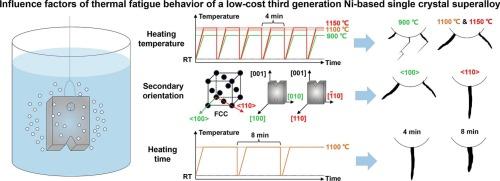低成本第三代镍基单晶超合金热疲劳行为的影响因素
IF 5.5
2区 材料科学
Q1 MATERIALS SCIENCE, CHARACTERIZATION & TESTING
引用次数: 0
摘要
研究了一种新型低成本镍基单晶高温合金热疲劳性能的影响因素。研究了低成本第三代镍基单晶高温合金的热疲劳行为受加热温度、加热时间和试样二次取向的影响,并对其机理进行了研究。加热温度从900℃提高到1100℃,可以抑制热疲劳裂纹以II型扩展。弹性模量和疲劳裂纹扩展速率的各向异性导致< 100 >和< 110 >试样的热疲劳性能和裂纹扩展方向存在差异。在一个热疲劳循环中,加热时间越长,裂纹尖端氧化越明显,裂纹尖端变钝,疲劳裂纹扩展速率降低。本文章由计算机程序翻译,如有差异,请以英文原文为准。

Influence factors of thermal fatigue behavior of a low-cost third generation Ni-based single crystal superalloy
Several influence factors of the thermal fatigue behavior of a novel low-cost Ni-based single crystal superalloy were investigated. Thermal fatigue behavior of a low-cost third generation Ni-based single crystal superalloy is affected by heating temperature, heating time and secondary orientation of the specimen, and corresponding mechanism was studied. An increase of heating temperature from 900 °C to 1100 °C inhibits thermal fatigue crack from propagating in Mode II. Anisotropy of elasticity modulus and fatigue crack propagation rate cause differences in thermal fatigue property and crack growth direction between 〈100〉 specimen and 〈110〉 specimen. Longer heating time in one thermal fatigue cycle results in more obvious oxidation at the crack tip, as well as crack tip blunting, decreasing fatigue crack propagation rate.
求助全文
通过发布文献求助,成功后即可免费获取论文全文。
去求助
来源期刊

Materials Characterization
工程技术-材料科学:表征与测试
CiteScore
7.60
自引率
8.50%
发文量
746
审稿时长
36 days
期刊介绍:
Materials Characterization features original articles and state-of-the-art reviews on theoretical and practical aspects of the structure and behaviour of materials.
The Journal focuses on all characterization techniques, including all forms of microscopy (light, electron, acoustic, etc.,) and analysis (especially microanalysis and surface analytical techniques). Developments in both this wide range of techniques and their application to the quantification of the microstructure of materials are essential facets of the Journal.
The Journal provides the Materials Scientist/Engineer with up-to-date information on many types of materials with an underlying theme of explaining the behavior of materials using novel approaches. Materials covered by the journal include:
Metals & Alloys
Ceramics
Nanomaterials
Biomedical materials
Optical materials
Composites
Natural Materials.
 求助内容:
求助内容: 应助结果提醒方式:
应助结果提醒方式:


